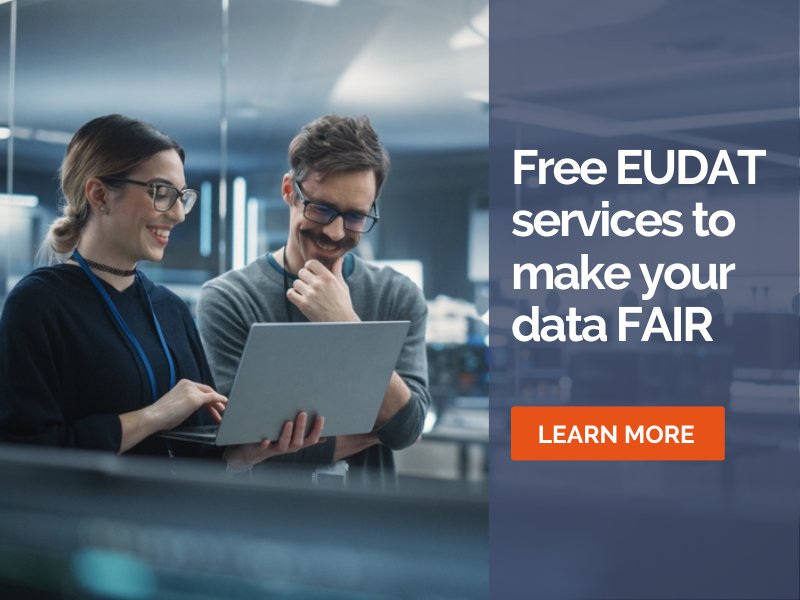
There can be no denying the many benefits of making research data FAIR (Findable, Accessible, Interoperable, and Reusable). But how can we do that if I don’t have the tools or there are no processes available at my disposal?
EUDAT envisions research data to be shared and preserved across borders and disciplines. While it does have customised solutions for institutions and communities, there are actually free services for research data management that individual researchers or even citizen scientists or policy makers can use! Check out these steps below.
Step 1. Register for EUDAT services
Start by registering for an EUDAT account if you don't already have one. EUDAT has B2ACCESS which allows prospective users to easily create credentials to access EUDAT services using your pre-existing academic institutional credentials, social, or email accounts.
B2ACCESS interface and functionalities

Step 2. Prepare your data
Start with the metadata. Ensure that you have enough information about your research data to be able to fill in the metadata to describe it. This metadata should include information about the dataset, its creators, keywords, licensing, and other relevant details.
Note that during the data sharing steps through the free and public B2SHARE instance, there are already fields that can help ensure you describe your research output with rich metadata. There are even built-in guides that can help you select the best licence, if this hasn’t been previously decided.
Step 3. Store your data
Use EUDAT's B2DROP data storage services to upload your research data. Users can already start with a free 20GB account to store their research data. B2DROP is a secure and trusted data exchange service for researchers and scientists to keep their research data synchronised and up-to-date and to exchange with other researchers.
B2DROP is an ideal solution to store and share data with colleagues and team members, synchronise multiple versions of data, and ensure automatic desktop synchronisation of large files. Only self registration is needed and can be accessed online. You can share files with local users, or across other B2DROP and ownCloud/Nextcloud instances. You can synchronise using desktop clients or WebDAV mounts. In addition, from within B2DROP, you can publish data to B2SHARE.
B2DROP at a glance

Step 4. Data Access and Sharing
Let’s take a second look at metadata and data description. If you’ve done step 2 well, then this step should be easier as you have the necessary metadata at hand to associate your metadata with your research data to be shared. From B2DROP or directly through B2SHARE, EUDAT offers the necessary functionalities for creating and managing metadata associated with your datasets.
You can encourage others to cite your data by providing a citation format and DOI for your dataset. You can use EUDAT's services to set access controls and permissions for your data through B2SHARE.
Make sure it is available through a persistent identifier (such as a DOI) for long-term access. You can do this through B2HANDLE which issues DOIs within the B2SHARE service.
B2SHARE interface and functionalities

Step 5. Ensure Data Interoperability and Reusability
For this step in making your outputs FAIR largely has to do with how well you implement these recommendations below and take them into account when starting to store and share your data using EUDAT services.
First, make your data more interoperable by using common data formats and standards relevant to your research domain. Additionally, provide clear licensing information for your data, specifying how others can use and reuse it. EUDAT's services can help in managing licences and providing proper attribution.
You should also think about the data structure. You should organise your data in a well-structured manner. Additionally, use standard or commonly-used file formats whenever possible.
It is best practice to also document your dataset thoroughly. You should explain the purpose of the data, how it was collected, any pre-processing steps, and any potential limitations. This documentation should be easily accessible and understandable. This supports reusability of your research data.
Finally, keep up to date!
Follow and meet with EUDAT experts who speak at various events related to open science, research data management and the European Open Science Cloud and get guidance on best practices and FAIR data principles.
You can also take advantage of EUDAT's training resources and workshops to improve your data management skills and learn about their services
By following these steps and leveraging EUDAT's free services and resources, you can significantly enhance the FAIRness of your research data, making it more valuable to the scientific community and beyond. Remember that FAIR data management is an ongoing process that requires continuous attention and updates as your research progresses - and throughout this EUDAT services are there to support you.
Interested to know more about how these services can help you? Write to us or start using the services now! Start with:
B2DROP or B2SHARE
(Accounts through B2ACCESS can be set-up either way)
